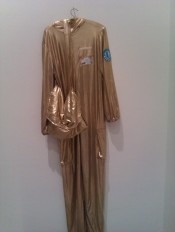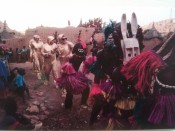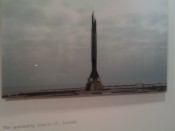Visiting the Arnolfini gallery in Bristol recently, I was intrigued to discover Superpower, an exhibition devoted to African science fiction (and there is more to the latter than District 9, although Neill Blomkamp, who directed that particular gem, was doubly represented by two micro-films playing on loop). The exhibition promised, to my companion‘s unceasing admiration, to ‘be reflexive of the ever-ubiquitous exhibition format of the regional or national showcase, foregrounding modes of representation rather than considering the artist as a regional representative’. That said, it was reassuring to discover that Slavic influences are also ever-ubiquitous. The wonderfully innovative Polish artist Paweł Althamer, who has previously taken this installation to Oxford, Brussels, and Brazil, is pictured exploring Mali with a small crew of faux-extraterrestrials from the Warsaw suburb of Bródno, all wearing Elvis-style gold lamé space suits. To quote the exhibition catalogue, Althamer and his companions travel the world ‘to create an alien encounter with new people and places. […] One of the classic allegories of science fiction – that of aliens invading the Western world who symbolize a fear of the ‘Other’ – is reversed, in this instance also playing with the oft-fabled beliefs of the Dogon in the extra-terrestrial’. In an interesting Fedorovian aside, Althamer called his travelling installation the ‘Common Task’ (Polish ‘Wspólna sprawa’; contrast Nikolai Fedorov’s ‘общее дело’). Althamer’s aesthetic and moral convictions, however, relate more to international fraternity than intergalactic resurrection. (You can watch an interview with the artist here.)
A second Slavic-themed installation was a series of photographs by Angolan artist Kiluanji Kia Henda, ostensibly logging a sun-landing exhibition called Icarus 13. Launched from and ultimately landed in Luanda, Angola with ‘a flight crew… composed of two astronauts and two beautiful air stewards, trained for one year before the launch in the desert of Namibia’, the diamond-and-steel, solar-powered craft sets off to gather samples from the surface of the sun. The tongue-in-cheek, mordantly detailed captions describe an impossibly utopian project that may remind readers of Engineer Los’s voyage to Mars in Aelita or the brief parabola of the Integral in Zamiatin’s We. To return to the catalogue: ‘Kia Henda’s project also suggests the melancholy in these monumental remains of a collective intervention into the future – the promise of a better world that Soviet states and post-colonial African nations shared, burned up like Icarus on a flightpath to the sun’.
Remember that Snail on the Slope always welcomes new ideas for blog posts, or guest blog posts on all relevant topics!




